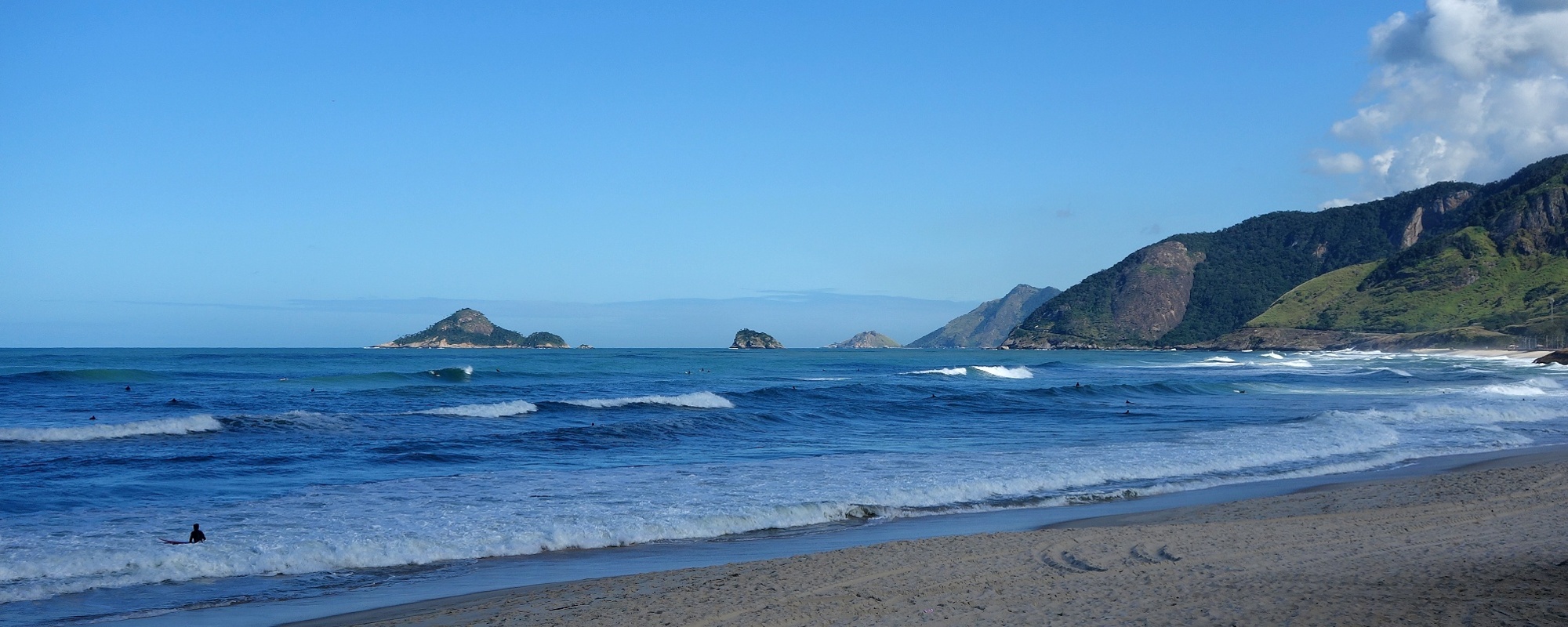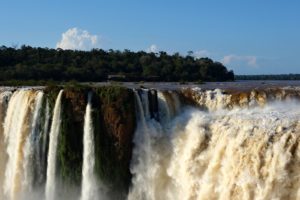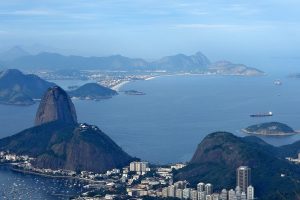Rio de Janeiro in Brazil is an amazing city that is great for sightseeing and outdoor activities.
It’s surrounded by beaches and mountains, making the landscape special.
If you like hiking, climbing or water sports like us, Rio is the place to go.
These are our top four outdoor activities in Rio de Janeiro:
1. Hiking To The Christ The Redeemer

No trip to Rio is complete without visiting Christ the Redeemer (Cristo Redentor).
It’s one of the New Seven Wonders of the World.
The statue of Jesus Christ is 30 metres tall and is located at the summit of Corcovado mountain (710 m/2330 ft).
Skip the queues for the touristy train, save money you would spend on a tour, minibus or taxi, and hike there instead.
The trail begins in the Parque Lage in the Jardim Botanico neighbourhood.
You can get there by bus or taxi.
It’s a nice park perfect for taking the break from the busi.
At the trailhead, you should register with the park rangers, who will give you a map.
The first part of the trail is easy and goes along a favela’s fence.
When we were there, it was quiet, and we didn’t meet anybody.
The path leads through the jungle, and it’s easy to follow.
It takes about two hours each way.
Some parts of the trail are steep, but the hike is rewarding.
You will see beautiful scenery, waterfalls, exotic plants, and cute little monkeys.
When you get to the top of Corcovado mountain, you will need to buy a ticket to access the statue of Christ the Redeemer.
Be prepared for crowds and loads of selfie sticks.
If you are lucky with the weather and there are no clouds, you will get breathtaking views of Rio, including the well-known Sugarloaf mountain.
The one-way ticket to get back downhill on the train is expensive; it’s almost the same price as the return ticket.
We asked the waiting minibus drivers, but none of them wanted to take us back because we didn’t have return tickets.
But we didn’t mind and walked back through the jungle.
Unfortunately, we underestimated the time we needed to get down and left the summit quite late.
We arrived at the Parque Lage in the dark, which was quite scary because we could hardly see the path, and we could have got lost in the jungle easily.
Luckily, we didn’t and found the park exit.
That’s why make sure you allow enough time for the descent to avoid situations like this.
2. Climbing Sugarloaf Mountain
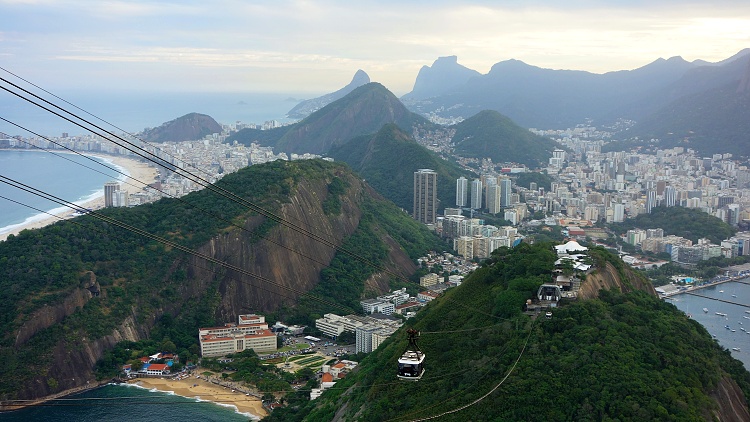
Sugarloaf Mountain (Pao da Acucar), rising just off the coast of the Atlantic Ocean, is one of the most famous landmarks in Rio.
There are two peaks on the peninsula in Guanabara Bay: the smaller Urca Mountain (Morro da Urca, 220 m/722 ft) and the taller Sugarloaf (396 m/1299 ft).
Sunset is the most popular time to visit because the views are incredible.
Most visitors use the cable car to access the mountains, stopping at both peaks.
We climbed Sugarloaf instead, and it was one of our most memorable experiences in Rio.
Unless you are an experienced climber with your climbing equipment, joining a tour with a climbing instructor is better because some parts of the track can be tricky.
It’s not recommended to climb Sugarloaf after the rain because the surface gets slippery.
The tour is suitable even for people with no climbing experience.
The instructor will guide you and give you a hand if needed.
We did the Sugarloaf Mountaineering Tour with Rio Adventures, and we really enjoyed it.
At the summit of Sugarloaf Mountain, you will get amazing views of Rio’s cityscape, Christ the Redeemer and the Copacabana beach.
When you are ready, you can take the cable car back.
We used it to get to Urca Mountain and walked downhill through the forest.
It was dark, so headlamps came in handy.
Make sure you are wearing comfortable clothes and hiking shoes.
Bring plenty of water and snacks with you.
Sugarloaf looks steep from the front, but the climbing tours usually access the mountain from the back, where the trail is more accessible.
Plan this adventure as a half-day trip.
Sugarloaf is a beautiful mountain to climb.
It’s a great feeling not to join the crowds in the cable cars but to conquer the mountain on your own.
If you don’t feel comfortable climbing Sugarloaf, you can take a walk to Urca Mountain and continue by cable car.
3. Hiking to Twin Brothers Mountain
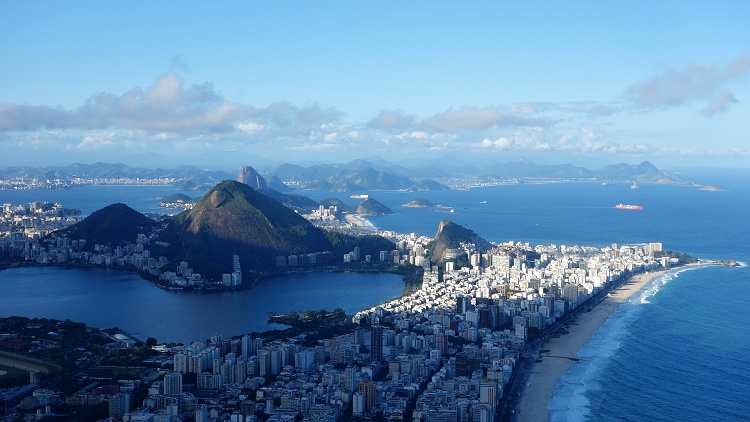
The rock formation called Twin Brothers (Morro Dois Irmaos) is 533 m (1749 ft) high.
It’s higher than Sugarloaf but lower than Corcovado Mountain.
The views from the top include Christ the Redeemer, Sugarloaf Mountain and Copacabana, Ipanema and Leblon beaches.
It’s located in the Vidigal neighbourhood in Rio.
Be aware that you must go through the Vidigal favela (a slum) to get to the trailhead.
If you aren’t comfortable with that, you can join a tour or hire a local guide.
Vidigal is one of the pacified favelas in Rio.
The entrance is located close to the Sheraton Hotel.
We had no issues there; nobody was paying attention to us.
We took the moto-taxi to get to the trail because the streets were really steep.
Moto-taxis are cheap, and you will support the local people by using them.
Using vans is also possible, but they are more expensive and slower than motorbikes.
You must get off the football field and follow the trail uphill.
The hike isn’t challenging; it takes about one hour each way.
After returning to the football field, we walked down through the favela.
It’s just a quick steep walk downhill through the narrow streets to get to the bus stop on the main road.
4. Water activities
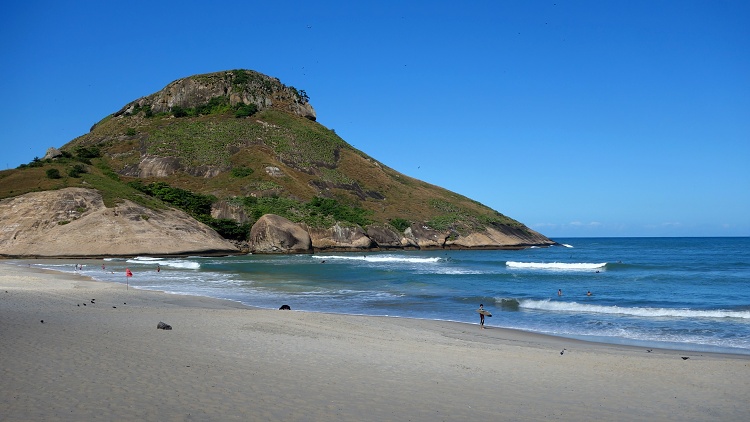
Rio is well-known for its gorgeous beaches, especially Copacabana and Ipanema.
Cariocas (the locals) love spending their time on the beach.
If the weather is right, the beaches can get really crowded.
Cariocas look after themselves, and you will see many good-looking people running or working out (not only) on the beach.
There are many workout stations available along the beaches.
In the evening, when it gets cooler, many people also join some outdoor workout classes.
We aren’t beach bums, but we still wanted to enjoy the ocean.
We tried stand-up paddle boarding at Copacabana and surfing at Praia da Macumba in the Recreio neighbourhood.
We didn’t have any previous experience with paddle boarding at that time, but the staff explained how it worked.
It’s easy enough (if you can keep the balance).
We aren’t experienced surfers, so we decided to join a group to learn some new tricks.
In the end, there were just three of us, so we all got much of the instructor’s attention.
We chose the surfing school Surf n Stay in Recreio because the prices were lower than in the city centre.
The district is quite far from Rio’s main tourist area (the South Zone).
You can take a public bus or taxi; it’s about an hour each way.
Travelling by bus might take forever because it stops often, but it’s a really authentic experience.
Extra Tip
Be aware that English isn’t widely spoken in Rio, even at the most touristy places like Copacabana beach.
If you are planning to go somewhere on your own, learn at least some essential words and phrases in Portuguese.
There is so much more to do in Rio de Janeiro; unfortunately, we didn’t have time to hike in the Tijuca National Park or try hang gliding as we originally planned.
Well, we will do it next time…
What about you? What are your favourite outdoor activities?
Did you like this article? Please share it so that more people can experience this great city.

